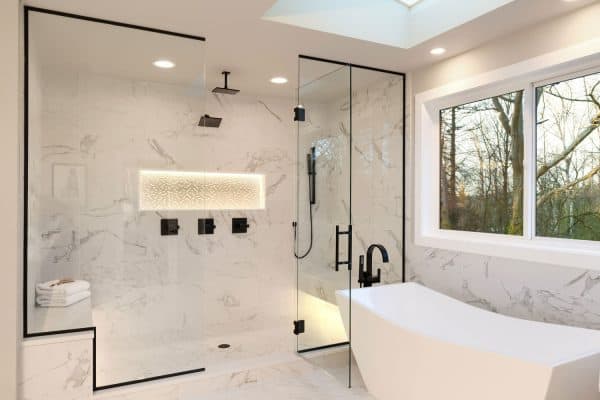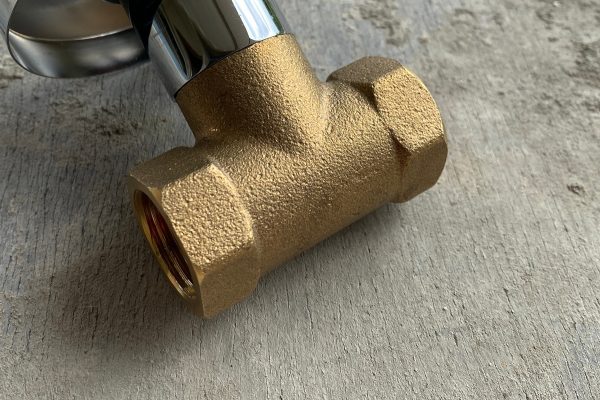Keeping the surfaces in your home looking brand-new can be challenging at times. For example, do you have bathroom counters that are turning yellow, and you have no idea what's happening? What is the reason for yellowing on bathroom countertops? Is it water damage?
Luckily, we've done plenty of research into this question and have the answer!
A bathroom countertop often turns yellow because of its wax application or top coating. Over time, this coating/sealer may change color, going from clear to yellow. Especially with lighter stone countertops, yellowing is a common issue that many homeowners struggle with.
However, removing these yellow stains should be as easy as using a mixture of baking soda, peroxide, and cool water on your countertops, although this may differ depending on the material.
As we start this article, we will cover yellowing countertops and show you how to fix them. Whether your bathroom counters are many years old, on the newer side, or need other cleaning tips and tricks, we're here to help. With that said, let's dive into this topic below!
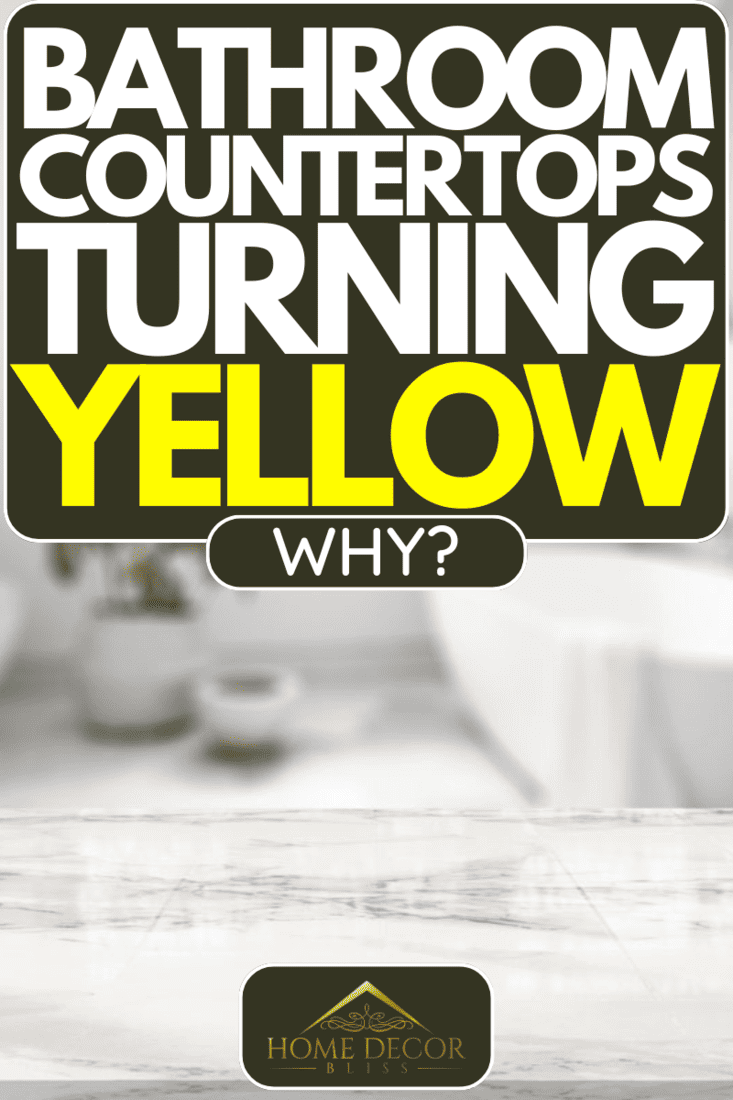
Why Are My Bathroom Countertops Turning Yellow?
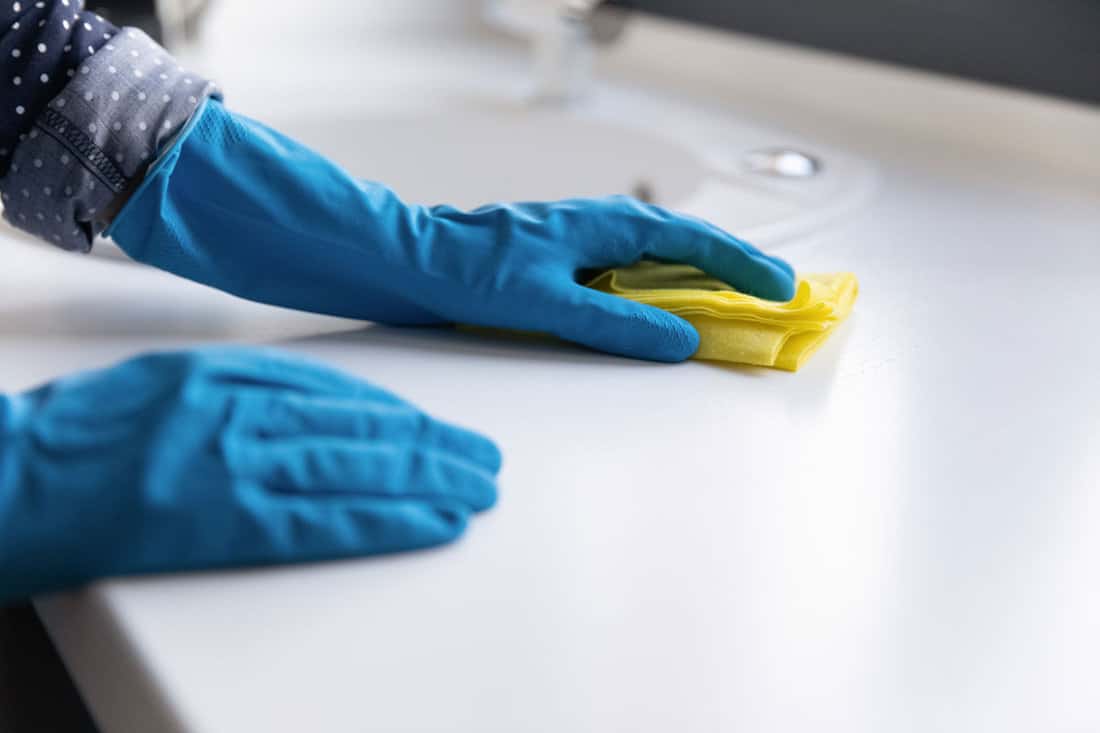
We may include affiliate links and curated AI content to highlight top design styles.
One of the main causes of yellowing countertops in the bathroom is exposure to water or other oxidizing chemicals. Most countertops have a seal or top coating that can become worn down over time.
This may also be a wax protectant for countertops, which often turn yellows as they age.
When this happens, you might notice a yellow undertone on lighter countertops. Although the bathroom is supposed to be moist, too much water over time can cause yellowing on your counters.
Therefore, it's a good idea to regularly wipe down your surfaces and reseal them every few years. Especially for natural stone, if your countertops aren't sealed or their protective top coat is worn down, staining and yellowing are imminent.
On top of that, a bathroom countertop may also be turning yellow because you're using harsh chemicals like bleach to clean it. Many professionals claim cultured marble countertops in rooms with poor ventilation can turn yellow over time.
The same goes for marble and any natural stone surface inside your bathroom. The more oxidation your countertops go through, the yellower/cloudier they will start to appear.
One way to improve this would be regular drying of your countertops and ensuring your bathroom has good ventilation.
Can You Fix A Yellowing Bathroom Countertop?
Yes, you should be able to clean off yellowing from a bathroom countertop. Typically, someone with a yellow counter should use a hydrogen peroxide-soaked cloth or towel and wipe down anywhere with the problem.
One benefit of peroxide is that it doesn't yellow surfaces but can lift staining and get your counters back to their original hue. That said, you don't want to scrub or apply too much pressure with your peroxide-soaked rag/cloth.
This can damage the protective coating on your countertops, meaning it will become exposed to the elements. If you damage your countertops while removing the yellow stains, you will need to reseal them.
According to experts, one may also want to try mixing equal parts vinegar and water in a spray bottle and use that to clean/whiten their counters.
Furthermore, you can add baking soda to your countertops and wipe them down with a cloth, which will also help lift and remove yellow staining.
The key is avoiding harsh chemical products while cleaning your bathroom countertops. One of the mistakes people make with trying to remove yellow stains from their counters is scrubbing them with bleach, which can make things worse.
Any product that will strip your countertops of their protective top finish should be avoided.
Can I Use Bleach On Yellow Bathroom Countertops?
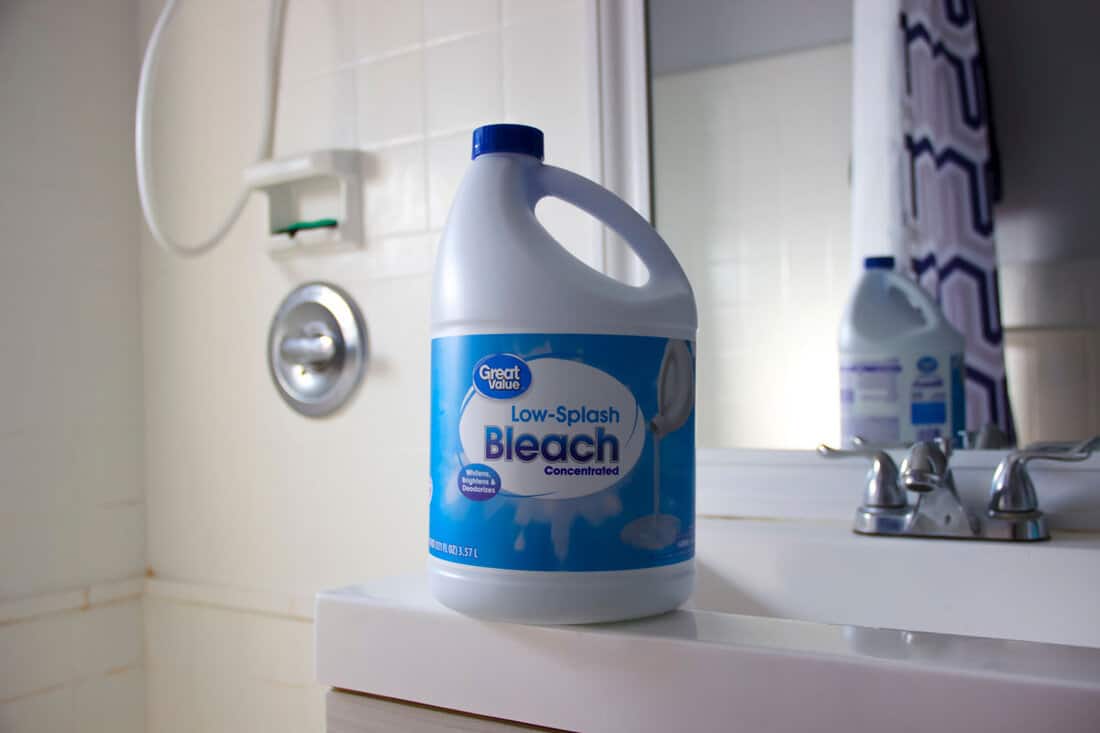
Although bleach can work miracles for stained items and kill bacteria, we don't recommend it for your bathroom countertops.
One of the main culprits for yellowing counters is cleaning with bleach too often, so using it to fix the problem wouldn't be productive.
Regularly using bleach to wipe down your countertops can damage their top coating, leading to overexposure to moisture/chemicals.
Therefore, when you use bleach on your countertops, you open the door to yellowing and staining. Of course, bleach won't damage all countertops, but if yours are natural stone/porous, do not use bleach to clean them.
The chemical composition in the bleach works to eat away any coating, wax, or sealant your counters have. Instead, we recommend using hydrogen peroxide, baking soda, white vinegar, or general cleansers to wipe down and sanitize your bathroom countertops.
These products shouldn't harm your counters and will get them shining. And for natural stones, like marble or granite, you might also want to use a specialty cleaner that polishes them.
Black Diamond Stoneworks Cleaner & Sealer
This countertop cleaner works for marble, granite, travertine, and limestone, features a hypoallergenic formula, includes a built-in sealer, is made in the USA, and comes in a 32-ounce bottle.
Follow this link to view it on Amazon.
How Do You Whiten Yellowed Laminate Bathroom Countertops?
For anyone with yellowing laminate bathroom countertops, there are a couple of ways to fix this. In general, you want to use baking soda and cold water and massage it into your laminate counters.
According to professionals, the best way to do this is by letting your baking soda sit on the yellowed counters for about five minutes before wiping them down.
It may even be worth using a plastic brush for stubborn areas, so that's one thing to remember. As we said above, hydrogen peroxide is another great whitener for countertops.
If you can soak a cloth in peroxide and gently wipe it across your laminate counters, they should become lighter and stain-free. Both methods require patience, so don't give up after the first try.
Once your countertops are back to their original colors, we recommend staying away from using harsh chemicals on them. Bleaching laminate is one of the leading causes of yellowing, so that's a product line to avoid.
Abrasive scrub brushes and cleaning tools can also cause your laminate to lose its protective top layer, so when in doubt, go with a soft rag or cloth.
How Do You Clean Yellow Formica Bathroom Countertops?
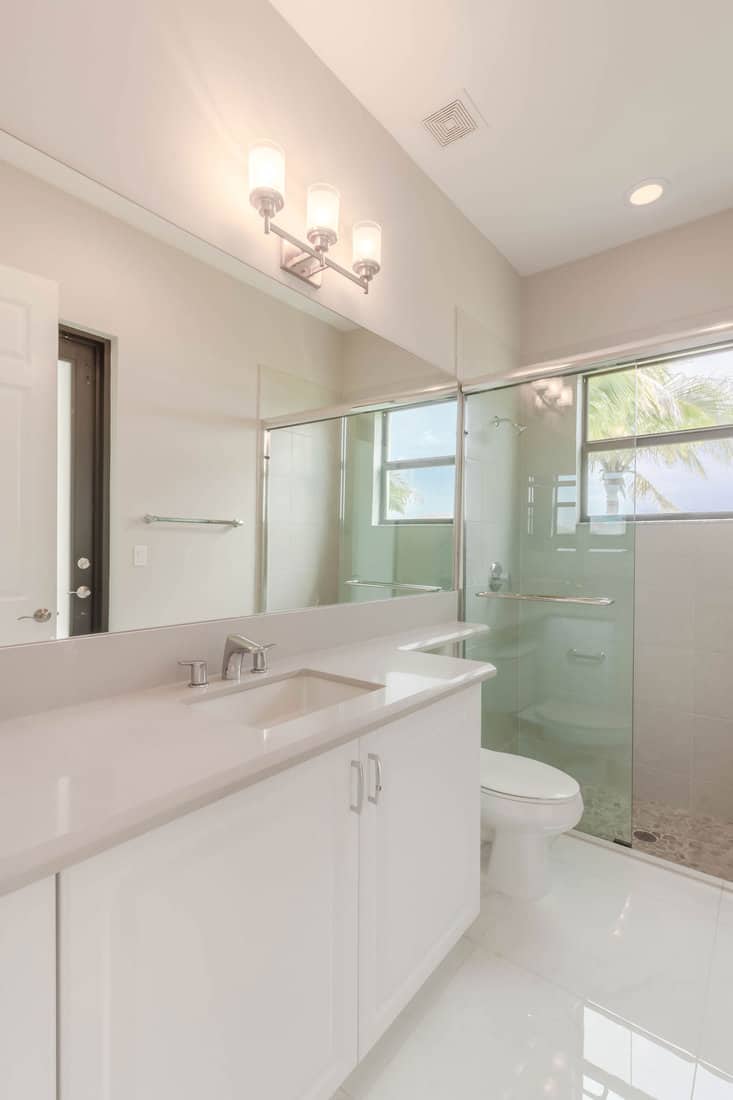
If you have Formica bathroom counters, you will eventually deal with yellow staining. However, cleaning this will be similar to laminate countertops, so make sure and grab a bleach-free cleaner.
Ideally, you will use an all-purpose cleanser and a bit of baking soda or peroxide to wipe down yellowing Formica surfaces. From there, you want to let your product sit on the Formica for a few minutes before getting started.
Since Formica is a laminated composite material, it's not as hardy as natural stone. Therefore, if you use abrasive products, Formica can quickly become damaged and yellow.
With synthetic countertops, you also need to be cautious of moisture. As we said, bathrooms with poor ventilation can cause yellowing countertops, especially for Formica.
It's also worth mentioning that because laminate and Formica countertops are essentially the same material, you can clean them the same way: without chemicals.
Baking soda is our top recommendation for deeper cleaning, while regular soap is fine for everyday wipe-downs. Try and keep your Formica countertops dry and avoid letting moisture collect on them for long periods.
Do Bathroom Countertops Need To Be Sealed?
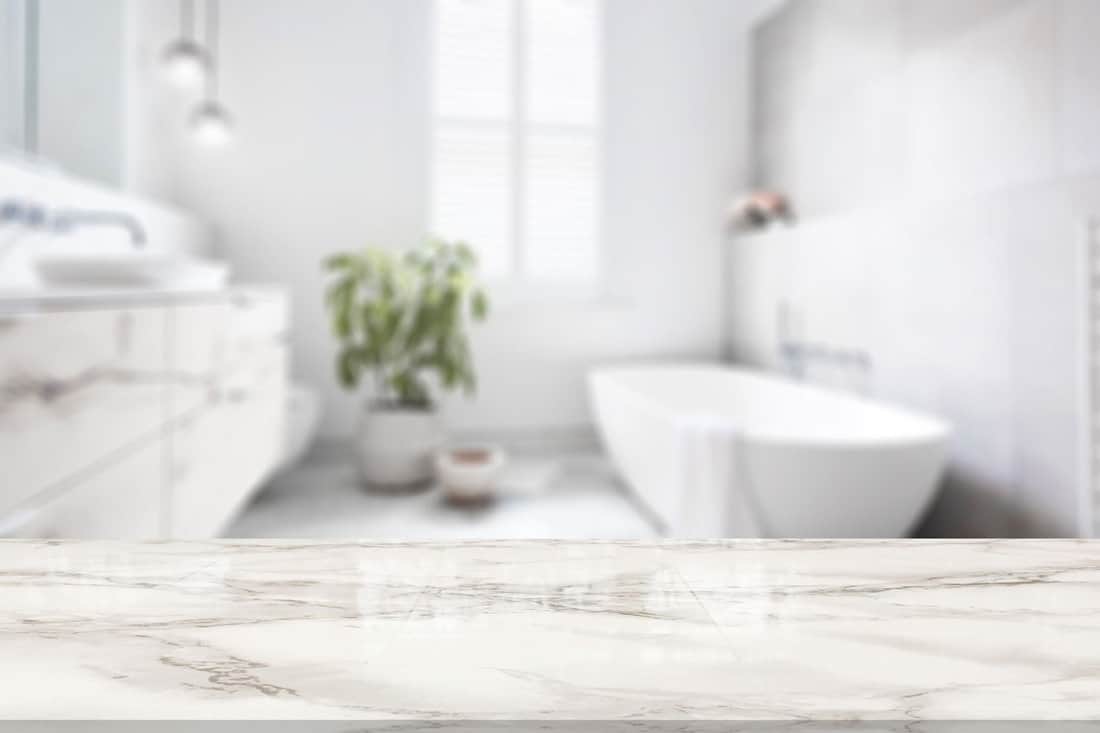
Yes, it is generally a good idea to seal bathroom countertops. Because of the traffic, moisture, and products your bathroom counters will experience, they need to be well-protected.
Whether your counters are marble, granite, quartz, Formica, laminate, porcelain, or anything else, giving them a top protective seal is always beneficial.
Of course, some countertops will be made in a way that seals them without additional products, like quartz, so in that case, you do not need to seal them.
Most artificial countertop materials will be created using ingredients that don't have pores. Non-porous countertops tend to repel water and stains better than those with pores because there's nowhere for these things to go.
For example, if you have natural marble countertops that aren't sealed, spilling hair dye/bath products or continued bleaching can destroy them.
That said, if your countertops are sealed with a resin dissolved in either water or a petroleum-based solvent, they will shine and repel moisture of any kind.
The key here is applying a sealer that is specific to your countertop. Not all products will be the same.
What Is The Best Bathroom Countertop Material?
When it comes to the best bathroom countertop material, we recommend installing quartz, granite, cultured marble, laminate, or even porcelain.
One of the best ideas for bathroom counters is one with a hard material or non-porous design. For example, natural stone counters have pores but are incredibly durable.
On the other hand, countertops like quartz are non-porous and durable, making them an excellent middle ground. Marble and granite tend to be more expensive but will give your bathroom a more elevated appearance.
Laminate is a good cost-effective countertop choice, but it may need more frequent replacement because it's synthetic. Porcelain is easy to clean and doesn't have pores, so we recommend it for anyone wanting a smooth, white countertop.
To Finish Up
Whether you're renovating, have had your countertops forever, or recently noticed yellow staining, it's always good to know how to fix this on your bathroom counters.
We found that yellowing bathroom counters usually indicate poor ventilation in your space, you're cleaning with bleaching products, or the top coat of your counters has worn off.
To remedy this, you need to clean your countertops with either hydrogen peroxide, baking soda, white vinegar, or an all-purpose soap. Next, you should seal them and avoid bleaching agents moving forward.
Want to read more about bathrooms? Here are a few related articles you'll love!
Why Do Bathroom Tiles Crack? (And How To Fix That)
Victorian-Style Bathroom Accessories (Inspiration and Shopping Links)


![Marble walled shower wall, 5 Best Types Of Shower Wall Panels To Consider For Your Bathroom Renovation [The Ultimate Guide]](https://homedecorbliss.com/wp-content/uploads/2023/07/shutterstock_2138160219-600x400.jpg)
